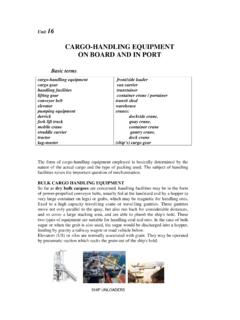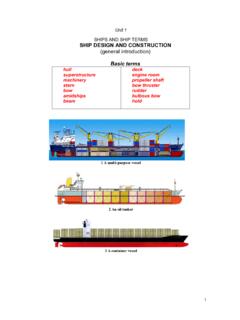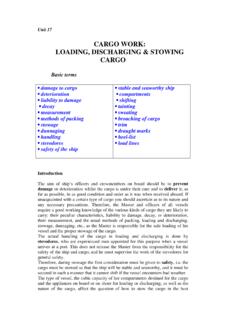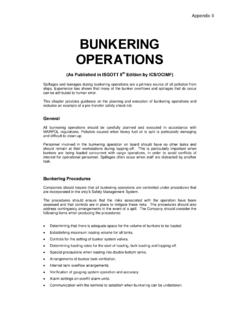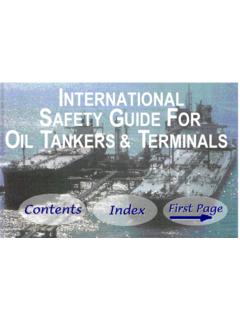Transcription of TANKER SAFETY GUIDE - pfri.uniri.hr
1 TANKER SAFETYGUIDE LIQUEFIEDS econd edition 1995 International Chamber of ShippingThe International Chamber of Shipping (ICS) is an organisation of national associations of shipowners and operators. Established in 1921, it now represents more than half of the world's merchant tonnage. The interests of ICS cover all aspects of maritime affairs, but it is particularly active in the field of maritime SAFETY , ship design and construction, pollution prevention, trade procedures and maritime law. ICS has consultative status with several inter-governmental organisations, notably the International Maritime the advice given in this GUIDE has been developed using the best information currently available, it is intended purely as guidance and to be used at the user's own risk. No responsibility is accepted by the International Chamber of Shipping, or by any person, firm, corporation or organisation who or which has been in any way concerned with the furnishing of information or data, the compilation, publication or authorised translation, supply or sale of this GUIDE , for the accuracy of any information or advice given herein or for any omission herefrom or for any consequences whatsoever resulting directly or indirectly from compliance with or adoption of guidance contained herein even if caused by a failure to exercise reasonable by the International Chamber of Shipping 12 Carthusian Street London EC1M 6 EBTelephone +44 171 417 8844 Fax+44 171 417 8877 First edition 1978 Second edition 1995 International Chamber of Shipping, London 1978.
2 1995 COPYRIGHT. No reproduction, copying, image scanning, storing or recording by any means in any form nor broadcasting or transmission through any medium of any part of this publication is permitted without the express written consent of the International Chamber of Shipping. All intellectual property rights 0-906270-03-0 British Library Cataloguing in Publication Data International Chamber of ShippingTanker SAFETY GUIDE (Liquefied Gas)Shipping - 2nd Edition1 TitleISBN 0-906270-03-0 Designed and printed byEdward Mortimer LtdPellon LaneHalifaxWest Yorkshire HX1 4 ADEngland+44 171 278 4010 ICS TANKER SAFETY GUIDE (LIQUEFIED CAS)iiPURPOSE AND SCOPEThe purpose of this publication is to provide those serving on ships carrying liquefied gases in bulk with up-to-date information on recognised good practice.
3 While the recommendations given may not fully cover every possible situation, they do provide the best general guidance currently available on safe procedures in such the purpose of promoting consistent and uniform safe working practices it is recommended that a copy of this GUIDE be kept - and used - on board all gas is a revision of the first edition of the ICS TANKER SAFETY GUIDE (Liquefied Gas) and is intended to be a companion to the ICS TANKER SAFETY GUIDE (Chemicals). Where a gas carrier is also certified to carry chemicals the more stringent recommendations should be GUIDE deals primarily with operational matters and good SAFETY practices. It does not make recommendations on the construction of gas ships or their equipment; such standards are set by the International Maritime Organisation (IMO), National Administrations and Classification Societies.
4 The GUIDE does not address the operation of specific items of equipment, repairs or navigational equipment, although some references are made to these should be borne in mind that in all cases the advice given in this GUIDE is subject to any local or national regulations that may be applicable. In addition, terminal operators have their own SAFETY procedures which could affect the cargo handling operations and procedures to be adopted in emergencies. It is necessary for the Master and all personnel to be aware of, and to comply with, these regulations and procedures. They will be highlighted by the use of the Ship/Shore SAFETY data sheets contained in this GUIDE outline the main characteristics of individual cargoes, and the action to be taken in an emergency. Matters relating solely to maintenance of the purity of individual cargoes and their condition during carriage have not been TANKER SAFETY GUIDE (Liquefied Gas) is a consolidation of experience and good operating practice in many companies.
5 The production of this second edition would not have been possible without the contribution of many individuals and organisations who have given their time and thanks are due to: the members of the ICS Gas-Carriers Sub-Committee, in particular its Chairman, Mr Ulf Tweita (Norway), Captain John Glover (UK) and Mr Carl Salicath Mortensen (Denmark); the directors and staff of the Centre for Advanced Maritime Studies, Edinburgh; the Secretariat of the Society of International Gas TANKER and Terminal Operators (SIGTTO); the Warsash Campus of the Southampton Institute of Higher Education;A special acknowledgement is made to the late Captain Alberto Allievi (Italy) a past member of the ICS Gas Carrier Sub-Committee and Director of the Centre for Advanced Maritime Studies in Edinburgh, for his personal contribution to the compilation of the data AND SCOPEThe purpose of this publication is to provide those serving on ships carrying liquefied gases in bulk with up-to-date information on recognised good practice.
6 While the recommendations given may not fully cover every possible situation, they do provide the best general guidance currently available on safe procedures in such the purpose of promoting consistent and uniform safe working practices it is recommended that a copy of this GUIDE be kept - and used - on board all gas is a revision of the first edition of the ICS TANKER SAFETY GUIDE (Liquefied Gas) and is intended to be a companion to the ICS TANKER SAFETY GUIDE (Chemicals). Where a gas carrier is also certified to carry chemicals the more stringent recommendations should be GUIDE deals primarily with operational matters and good SAFETY practices. It does not make recommendations on the construction of gas ships or their equipment; such standards are set byiiiACKNOWLEDGEMENTThe TANKER SAFETY GUIDE (Liquefied Gas) is a consolidation of experience and good operating practice in many companies.
7 The production of this second edition would not have been possible without the contribution of many individuals and organisations who have given their time and thanks are due to: the members of the ICS Gas-Carriers Sub-Committee, in particular its Chairman, Mr Ulf Tweita (Norway), Captain John Glover (UK) and Mr Carl Salicath Mortensen (Denmark); the directors and staff of the Centre for Advanced Maritime Studies, Edinburgh; the Secretariat of the Society of International Gas TANKER and Terminal Operators (SIGTTO); the Warsash Campus of the Southampton Institute of Higher Education;A special acknowledgement is made to the late Captain Alberto Allievi (Italy) a past member of the ICS Gas Carrier Sub-Committee and Director of the Centre for Advanced Maritime Studies in Edinburgh, for his personal contribution to the compilation of the data Subjectii INTRODUCTIONiii PURPOSE AND SCOPEiv ACKNOWLEDGEMENTv CONTENTSxiv DEFINITIONS1 CHAPTER 1 THE PROPERTIES AND HAZARDS OF LIQUEFIED GASES1 Introduction1 Flammability1 Health Hazards1 Toxicity1 Asphyxia1 Anaesthesia2 Frostbite2 Reactivity2 Reaction with water.
8 Hydrate formation2 Self-reaction3 Reaction with air3 Reaction with other cargoes3 Reaction with other materials3 Corrosivity4 Vapour characteristics4 Low temperature effects4 Brittle fracture4 Spillage4 Cooldown5 Ice formation 5 Rollover5 Pressure6 High and low pressure effects 6 Pressure surge6 Pressurised systems6 Reciprocating compressors6 Cargo tank pressures7 Liquid gas samples 7 Sloshing7 Pressure relief valves7 Cargo heat exchangers9 CHAPTER 2 GENERAL PRECAUTIONS9 Introduction9 Cargo information9 Moorings10 Emergency towing-off wires[CS TANKFR SAFF'IY CUIDF (LIQUEFIFD CAS)]
9 Access to Means of Unauthorised Persons smoking or Craft alongside11 Weather precautions11 Wind conditions11 Electrical storms11 Cold weather12 Dispersal of vented cargo vapours12 Openings in deckhouses and superstructures12 Engine and boiler room precautions12 Combustion equipment12 Blowing boiler tubes12 Cargo vapour13 Cargo machinery room precautions 13 Ship's readiness to move13 Navigation13 Pollution prevention14 Fire-fighting and fire protection equipment14 Helicopters15 CHAPTER 3 FIRE HAZARDS AND precautions 15 Introduction15 Flammability of liquefied gases16 Cargo vapour generation and disposal16 Atmosphere control16 General16 Hold and interbarrier spaces16 Cargo tanks and piping systems17 Inert gas quality17 Inert gas hazards and precautions17 precautions against sources of ignition17 Smoking18 Portable electrical equipment18 Communication equipment in port18 Use of tools19 Aluminium equipment and paint19 Ship-shore insulating.
10 Earthing and bonding20 Auto-ignition20 Spontaneous combustionviPage Subject20 Hot work20 General20 Assessment of hot work21 Preparations for hot work21 Checks by officer responsible for SAFETY during hot work23 Static electricity23 Electrostatic generation23 Steam23 Carbon dioxide24 Fire-fighting and fire protection equipment24 Fire-fighting equipment24 Flame arresters and gauze (flame) screens24 Inert gas25 CHAPTER 4 CARGO OPERATIONS 25 Introduction25 Responsibility25 Commissioning the cargo system26 General cycle of cargo operations26 Preparation for cargo transfer26 General27 Pressure surge28 Inerting and purging28 General28 Inerting29 Purging29 Methods of inerting and purging30 Preparation for loading30 General30 Cooldown30 Ice or hydrate formation31 Minimum cargo tank temperature31 Cargo loading32 Cargo conditioning32 General32 Reliquefaction and boil-off control34 Use of cargo as fuel35 Cargo discharge36

